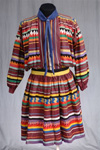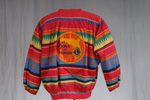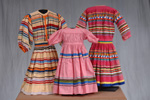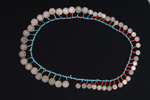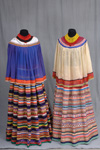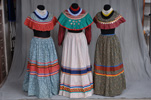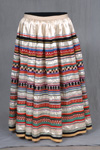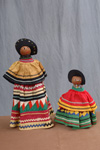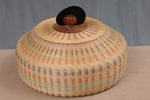Selected Artifacts
Big shirt, style of 1920s
The big shirt continued to be worn as late as the 1950s by some traditional Seminole men. This big shirt was made in 1956 on the Brighton Reservation.
(Norton Collection, Museum of Florida History)
The big shirt continued to be worn as late as the 1950s by some traditional Seminole men. This big shirt was made in 1956 on the Brighton Reservation.
(Norton Collection, Museum of Florida History)
Big shirt, style of 1920s
Dan R. Schwartz of Jacksonville wore this patchwork jacket to the Lions Club International Convention in New Jersey. The Florida Lion's Club members chose to wear patchwork jackets beacuse of its association with Florida's Seminole Indians.
(Collections of the Museum of Florida History)
Dan R. Schwartz of Jacksonville wore this patchwork jacket to the Lions Club International Convention in New Jersey. The Florida Lion's Club members chose to wear patchwork jackets beacuse of its association with Florida's Seminole Indians.
(Collections of the Museum of Florida History)
Children's clothing
Left to right: Big Shirt, ca. 1927; dress, ca. 1955; big shirt (back view), style of 1930s, ca. 1955. Jane Tiger Motlow (Otter clan) made the dress and pink big shirt in the mid-1950s.
(Collection of the Museum of Florida History)
Left to right: Big Shirt, ca. 1927; dress, ca. 1955; big shirt (back view), style of 1930s, ca. 1955. Jane Tiger Motlow (Otter clan) made the dress and pink big shirt in the mid-1950s.
(Collection of the Museum of Florida History)
Necklace, ca. 1910-1930
Miami John Tiger (Bird clan) used both silver dimes and quarters to make this necklace.
(Norton Collection, Museum of Florida History)
Miami John Tiger (Bird clan) used both silver dimes and quarters to make this necklace.
(Norton Collection, Museum of Florida History)
(Left) Cape and shirt, ca. 1954
Jane Tiger Motlow (Otter clan) made this striking ensemble.
(Norton Collection, Museum of Florida History)
Jane Tiger Motlow (Otter clan) made this striking ensemble.
(Norton Collection, Museum of Florida History)
(Right) Cape and skirt, ca. 1935-1945
Over time, patchwork evolved into more intricate designs with three or more colors. Use of rickrack on Seminole clothing became more widespread in the 1930s.
(Collections of the Museum of Florida History)
Women's outfits, style of late 1800s
These women's garments were made in the early 1950s to represent Seminole women's clothing of the late 1800s. At that time, calico was the primary material used for clothing and silver brooches were commonly sewn onto blouses. Two of the three examples shown here are missing sleeves. The outfit on the right was made by Jane Tiger Motlow (Otter clan).
(Norton Collection, Museum of Florida History)
These women's garments were made in the early 1950s to represent Seminole women's clothing of the late 1800s. At that time, calico was the primary material used for clothing and silver brooches were commonly sewn onto blouses. Two of the three examples shown here are missing sleeves. The outfit on the right was made by Jane Tiger Motlow (Otter clan).
(Norton Collection, Museum of Florida History)
Skirt, ca. 1954
Jane Tiger Motlow (Otter clan) made the ivory satin skirt, which features several bands of intricate patchwork.
(Norton Collection, Museum of Florida History)
Jane Tiger Motlow (Otter clan) made the ivory satin skirt, which features several bands of intricate patchwork.
(Norton Collection, Museum of Florida History)
Palmetto dolls, ca. 1940-1950s
Palmetto fiber became the primary material used to make dolls by the 1940s, but its earliest use dates to around 1918. Dolls such as these were often purchased by tourists from Seminole women.
(Collections of the Museum of Florida History)
Palmetto fiber became the primary material used to make dolls by the 1940s, but its earliest use dates to around 1918. Dolls such as these were often purchased by tourists from Seminole women.
(Collections of the Museum of Florida History)


